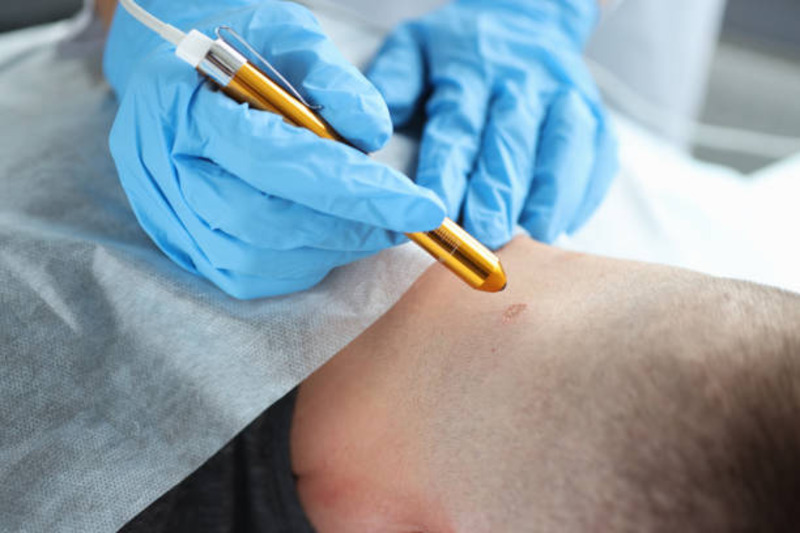Skin Tag Vs. Mole: Differences And Similarities
Feb 07, 2024 By Madison Evans
Are you noticing a new blemish on your skin and wondering if it’s something serious or just an innocuous growth? It can be hard to tell the difference between common skin anomalies like moles and skin tags from benign but unfamiliar ones. So if you're curious to learn more about the differences between a mole and a skin tag so that you know the best way to take care of them in order to avoid any further health problems or risks down the line read on!
What are Skin Tags and Moles and How do they Differ Physically?
Skin tags and moles are two common skin growths that can appear on different areas of the body.
- Skin tags, are generally small, soft pieces of skin that are connected to the body by a stalk. They often occur in areas where skin rubs against skin, such as underarms, neck, and groin. Moreover, skin tags are typically flesh coloured or slightly darker and are usually benign.
- Moles, on the other hand, are a concentration of pigment producing cells called melanocytes. They appear as dark or brown spots on the skin and can vary in size and shape. Unlike skin tags, moles typically appear during childhood or adolescence and are often present from birth.

Causes Of Skin Tags And Moles:
Skin tags and moles are two common skin growths that can appear on anyone, regardless of age or gender. While they are often harmless, they can be unsightly and cause irritation depending on their location.
- Skin tags are typically caused by friction and rubbing of the skin, particularly in areas where skin folds or creases, such as the neck, underarms, and groin.
- Moles are caused by the clustering of pigment cells, which can appear anywhere on the skin.
It's important to keep an eye out for any changes in size, shape, or color that could be a sign of something more serious.
Diagnosing Skin Tags and Moles:
- Skin tags are typically small, flesh colored growths that hang off the skin.
- Moles are typically round, dark spots that can appear anywhere on the body.
If you are concerned about a skin tag or mole, it is important to have it examined by a dermatologist who can accurately diagnose the growth and provide any necessary treatment. Early detection and proper diagnosis are key to maintaining healthy skin.
Treatment Options For Skin Tags And Moles:
Skin tags and moles, although usually harmless, can be unattractive or even annoying. Fortunately, there are several treatment options available for those who wish to get rid of them.
- One option is to have them surgically removed by a dermatologist. This procedure involves numbing the area with a local anesthetic and then cutting the skin tag or mole off with a scalpel.
- Another option is to freeze the tag or mole off using liquid nitrogen. This method is called cryotherapy and is usually done in a dermatologist's office.
- A third option is to use over the counter creams or solutions that are designed to dissolve the skin cells of the tag or mole.
Regardless of the treatment option chosen, it is important to consult with a healthcare professional to ensure that the skin tag or mole is not cancerous.
Prevention Tips for Skin Tag & Mole Development:
Taking care of our skin is crucial to maintain a healthy lifestyle. Skin tags and moles can appear on our bodies unexpectedly and can cause discomfort or even affect our self esteem. Luckily, there are several ways we can help prevent the development of these pesky skin growths.
- Protect our skin from harmful UV rays by applying sunscreen regularly.
- Avoid excessive sun exposure, especially during peak hours.
- Main a healthy diet and exercising regularly can also help prevent skin growths.
- Monitor any changes on our skin and seek medical attention if necessary.
By following these simple tips, we can help keep our skin healthy and free from unwanted growths.
When to See a Doctor about Skin Tags or Moles?

If you notice any sudden growth, changes in color or texture, or if they become painful or itchy, you may want to schedule an appointment with your healthcare provider.
If the mole or skin tag is in a location where it's frequently irritated by clothing or jewelry, it may be worth having it removed for comfort reasons. Ultimately, it's always best to err on the side of caution and have any concerns addressed by a medical professional.
Conclusion:
Taking care of our skin is an integral part of living a healthy lifestyle, and understanding the differences between moles and skin tags can greatly assist in helping us make informed decisions about our skin care. Accordingly, take the time to learn more about moles and skin tags, their causes, diagnoses, treatments, and most importantly when you should consult a doctor. Depending on your individual needs for skin tag or mole removal, there is no one size fits all solution available. It is highly recommended that individuals consult with their doctor before seeking any further treatment options.

Techniques to Maintain and Improve Your Posture as You Grow Older

Know The Stinging Nettle Benefits, Uses, and Side Effects

What Does 'Moderate-Intensity Exercise' Mean Anyway: An Overview
Understanding How OCD Medication Affects Your Personality

How to Spot a Magnesium Deficiency: 7 Key Signs

6 easy bowl recipes for a wholesome and nutritious dinner

The Pros and Cons of Adopting a Polyphasic Sleep Schedule


